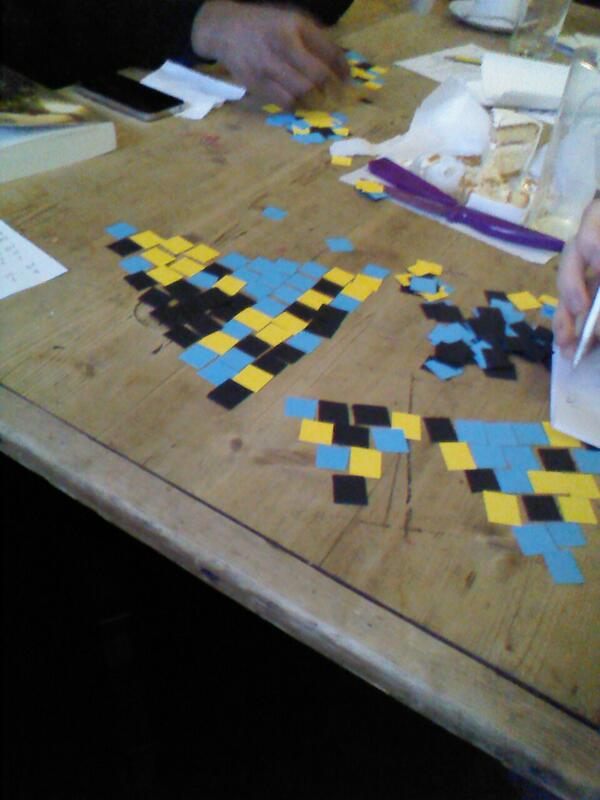MathsJam this month fell on the day before my birthday, which meant not only was our ‘Jam well supplied with birthday cake, but there was a jubilant mood only aided by the presence of some puzzles I’d written for my birthday party. Everyone had a good crack at the maths-related one, and found it entertaining (see: future Puzzlebombs, where said puzzles will almost certainly feature).
 We also had a go at Steve Humble’s triangle thing, which can be described as follows: Starting with a randomly-generated row of ten coloured squares, each one of three different colours, build a triangle by adding rows of length 9,8,7 etc underneath using the following rules:
We also had a go at Steve Humble’s triangle thing, which can be described as follows: Starting with a randomly-generated row of ten coloured squares, each one of three different colours, build a triangle by adding rows of length 9,8,7 etc underneath using the following rules:
- if the two squares above are the same colour, use that colour for the square below;
- if the two squares above are different colours, use the third (unused) colour for the square below.
Proceeding by these rules, it turns out you can predict the colour of the bottom square by applying the rule above to the two squares at the ends of the top row. This impressed our MathsJam attendees, some of whom had had as few as one and a half pints at this stage. This rule works for a row of ten squares as a starter, but will it work for other sizes of triangle?
Steve, in collaboration with Ehrhard Behrends, has written an article about this in The Mathematical Intelligencer, which describes their use of it as a street maths show, as well as their conjecture about which values of triangle size will work. I’ve since found the full text of the article, although some of our attendees were far too impatient for that and wrote a proof that this will always work for numbers of the form conjectured to work in the first part of the article. Meanwhile, the rest of us continued to have fun playing with square bits of coloured paper.
Another item briefly touched on was that of the Picross, or Nonogram (also known as Hanjie or Griddlers), which is a logic puzzle in which a blank grid is given along with a set of numbers for each row and column. The numbers describe the sizes of the groups of squares in that row or column, and you can use this information to reconstruct an image by colouring in the right squares. So for example, if a row is labelled 1,2,1, it means there’s a gap of indeterminate width, then a single square, then another gap, then two squares together, then another gap, then one square, and a gap at the end. There must be at least one square between clusters of squares, and it’s possible to use this along with the width of the whole row, and data from the columns, to make deductions about what lies where, (and crucially, which squares must be blank – like in minesweeper).
We had printed some easy, medium and hard puzzles for people to have a go at, and my plan was to see if we could come up with a method to check whether a given grid of black and white squares, when represented using this row and column data, can be reconstructed by solving such a puzzle. This won’t be true of all layouts (for example, a chessboard layout of squares has two valid solutions). It turned out that one of the attendees has already written a program to do this, which killed that one dead in the water, but at least I get to borrow it.
 Since it was apparently World Book Night (not sure how that differs from World Book Day, 8th March), I also brought along some recommended mathematical reading material, which we all leafed through and chatted about, before we tried some of the puzzles from Ian Stewart’s Cabinet of Mathematical Curiosities, and discussion fell to how it is you know that of the two guards, one only ever lies and one tells the truth? Is there a sign which explains this? And if so, which guard made the sign?
Since it was apparently World Book Night (not sure how that differs from World Book Day, 8th March), I also brought along some recommended mathematical reading material, which we all leafed through and chatted about, before we tried some of the puzzles from Ian Stewart’s Cabinet of Mathematical Curiosities, and discussion fell to how it is you know that of the two guards, one only ever lies and one tells the truth? Is there a sign which explains this? And if so, which guard made the sign?
We finished by playing a massive game of Perudo (also called Liar’s Dice), which we’ve played before, and since games take a long time, that was the rest of our MathsJam (other than occasionally chipping in with other MathsJam puzzles from Twitter, and cramming our faces with birthday cake and sharing bags of crisps). All in all, a successful night.